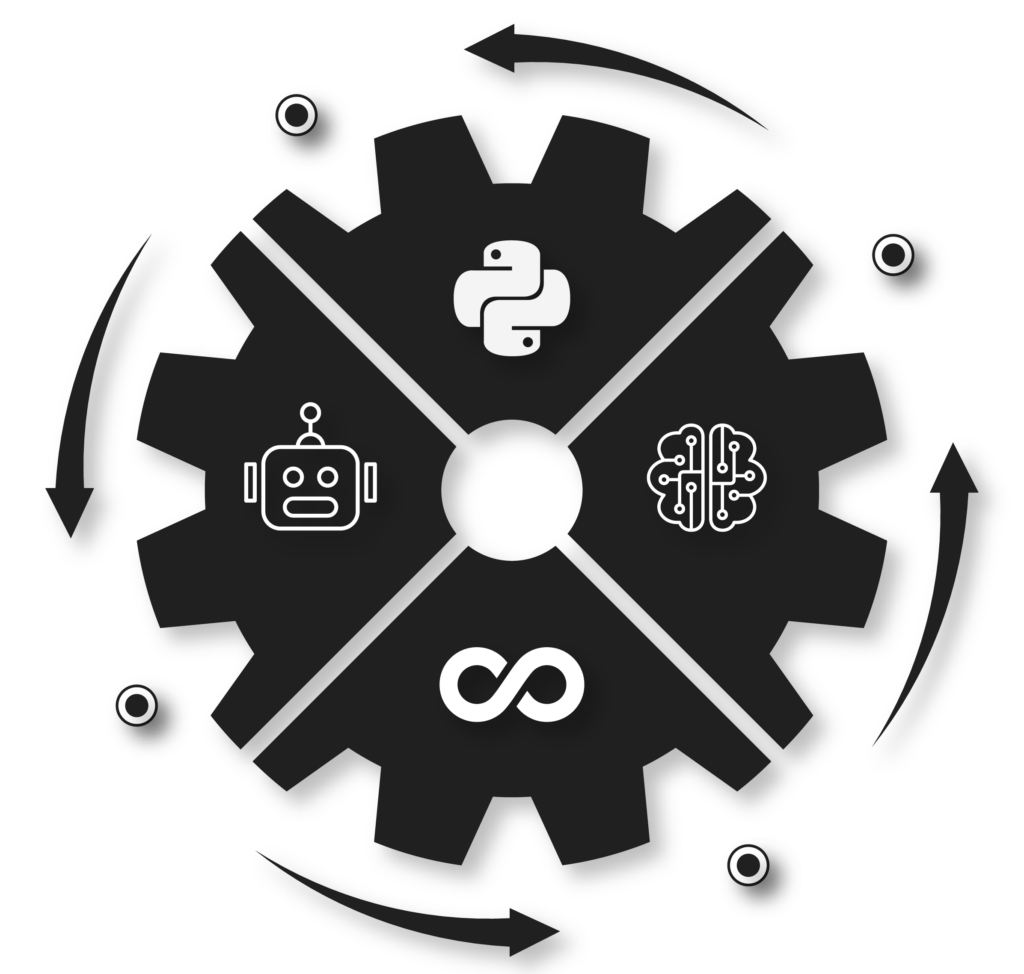


Artificial Intelligence Bootcamp
- Online
- 3 Months
- 4th November
- Monday-Thursday 7pm-9pm (PKT)
Eligibility
Currently enrolled or have graduated with a bachelor's degree in;
- Computer Science or related fields
- Any Engineering Discipline (Mechanical, Electrical, Civil etc)
Course Description
National university of Science and Technology (NUST) Islamabad and atomcamp jointly present the Artificial Intelligence bootcamp cohort 3.
This bootcamp is designed to train you with the skills needed to thrive in Artificial Intelligence (AI) and Machine Learning (ML).
It will guide you through Python, which is the main programming language used in AI. Additionally, we will build your expertise in other domains like Natural Language Processing (NLP), Computer Vision (CV), and Machine Learning Operations (MLOps).
Join us on this journey and become a future-ready in AI.

Course Curriculum
Installation
- Introduction to the Python programming language and its applications
- Setting up the Python environment: installation of Python and necessary libraries
Python Basics I
- Introduction to Python: history, features, and advantages
- Expressions and operators: arithmetic, assignment, comparison, and logical
- Understanding type() function and type inference
- Introduction to data structures: lists, tuples, and dictionaries
Python Basics II
- Recap of Python basics
- Working with arithmetic operators: addition, subtraction, multiplication, division, modulus, and exponentiation
- Using comparison operators: equal to, not equal to, greater than, less than, etc.
- Logical operators: and, or, and not
- Exploring advanced data types: sets and strings manipulation.
Expressions, Conditional Statements & For Loop
- Evaluating expressions: operator precedence and associativity
- Introduction to conditional statements: if, elif, and else
- Executing code based on conditionals.
- Understanding the flow of control in conditional statements
- Iteration using the for loop: range(), iteration over lists, and strings.
While loop, Break and Continue Statements, and Nested Loops
- Working with while loop: syntax, conditions, and examples
- Combining loops and conditionals
- Using the break statement to exit loops prematurely.
- Utilizing the continue statement to skip iterations.
- Implementing nested loops for complex iterations
Functions
- Introduction to functions: purpose, advantages, and best practices
- Defining and calling user-defined functions
- Parameters and arguments: positional, keyword, and default values
- Return statement and function output.
- Variable scope and lifetime
- Function documentation and code readability
Exception Handling and File Handling
- Understanding exceptions: errors, exceptions, and exception hierarchy
- Handling exceptions using try-except blocks: handling specific exceptions, multiple exceptions, and else and finally clauses.
- Raising exceptions and creating custom exception classes
- File handling in Python: opening, reading, writing, and closing files.
- Working with different file modes and file objects
Python Modules: NumPy,Pandas and Matplotlib
- Introduction to the NumPy module: features and applications
- Working with multidimensional arrays: creation, indexing, slicing, and reshaping
- Performing element-wise operations: arithmetic, logical, and statistical
- Overview of the Matplotlib module: data visualization and plotting
- Customizing plots: line properties, markers, colors, labels, and legends
Advanced Topics
- Introduction to Kaggle platform: features and benefits
- Leveraging Kaggle for real-life datasets: data exploration, analysis, and visualization
Introduction and Missing Value Analysis
- Introduction to Exploratory Data Analysis (EDA)
- Importance of EDA in data analysis
- Steps involved in EDA
- Handling missing values: identification, analysis, and treatment strategies • Imputation techniques for missing values
Data Consistency, Binning, and Outlier Analysis
- Data consistency checks using fuzzy logic
- Binning and discretization techniques for continuous variables
- Outlier detection and analysis methods
- Handling outliers: techniques for treatment or removal
Feature Selection and Data Wrangling
- Importance of feature selection in EDA
- Feature selection techniques: filter methods, wrapper methods, and embedded methods
- Data wrangling: cleaning and transforming data for analysis
- Handling categorical variables: encoding techniques
Inference, Hypothesis Testing, and Visualization
- Inference and hypothesis testing in EDA
- Common statistical tests: t-test, chi-square test, ANOVA, etc.
- Visualization techniques for EDA: histograms, box plots, scatter plots, etc.
- Hands-on practical session for complete EDA using a dataset
Machine Learning Performance Metrics and Naive Bayes
- Evaluation metrics for classification problems: accuracy, precision, recall, F1 score, etc.
- Introduction to Naive Bayes algorithm and its applications
- Implementing Naive Bayes for classification tasks
Logistic Regression, SVM, Decision Trees, and Random Forests
- Logistic Regression: theory, interpretation, and applications
- Support Vector Machines (SVM): concepts, kernels, and use cases
- Decision Trees: construction, pruning, and interpretability
- Random Forests: ensemble learning and feature importance
- Bagging and Boosting: techniques for improving model performance
Hyperparameter Tuning, PCA, and SVD
- Hyperparameter tuning techniques: grid search, random search, and Bayesian optimization
- Principal Component Analysis (PCA): dimensionality reduction and feature extraction
- Singular Value Decomposition (SVD): applications in matrix factorization and data compression
Clustering Introduction, Partitioning Algorithms, and Cluster Evaluation
- Introduction to clustering: unsupervised learning technique
- Partitioning algorithms: K-means, K-medoids
- Hierarchical clustering: agglomerative and divisive approaches
- Density-based clustering: DBSCAN, OPTICS
- Cluster evaluation metrics: silhouette coefficient, Davies-Bouldin index
Regression and Evaluation of Regression Methods
- Introduction to regression analysis
- Linear regression: assumptions, interpretation, and model evaluation • Evaluation metrics for regression: mean squared error, R-squared, etc.
- Other regression methods: polynomial regression, ridge regression, lasso regression
Introduction to Time Series and Time Series Forecasting
- Concepts and characteristics of time series data
- Time series components: trend, seasonality, and noise
- Popular time series forecasting models: ARIMA, SARIMA, exponential smoothing • Implementing time series forecasting models
Models and Hyperparameter Tuning
- Evaluation metrics for time series forecasting: mean absolute error, mean absolute percentage error, etc.
- Cross-validation techniques for time series data
- Hyperparameter tuning for time series models
- Introduction to NLP and Text Normalization
- Overview of Natural Language Processing (NLP)
- Techniques for text normalization: lowercasing, punctuation removal, etc.
- Text Representation and Tokenization
- Introduction to vectors in NLP: Bag of Words and Count Vectorizer
- Basics of tokenization and stopword removal
- Stemming, Lemmatization, and N-gram Language Models
- Understanding and applying stemming and lemmatization
- Introduction to N-gram language models
- Markov Models and Language Model Evaluation
- Basics of Markov models in NLP
- Techniques for evaluating language models: probability smoothing and performance metrics
- Text Classification Fundamentals
- Overview of Text Classification
- Introduction to Naive Bayes and Sentiment Classification
- Advanced Classifiers and Vector Semantics
- Generative vs. discriminative Classifiers
- Understanding vector semantics and embeddings: TF-IDF theory and vector similarity
- Neural Word Embeddings and Sequence Models
- Introduction to neural word embeddings: Word2Vec and GloVe
- Exploring sequence of words in NLP tasks
- Transformers and Large Language Models
- Overview of transformers and their impact on NLP
- Introduction to large language models (LLMs) and their applications
Computer Vision
- Cascade and HOG classifiers to detect faces
- Face detection using OpenCV and Dlib library
- Detect other objects using OpenCV, such as cars, clocks, eyes, and full body of people
- KCF and CSRT algorithms to perform object tracking
- convolutional neural networks and implement them using Python and TensorFlow
- Detect objects in images in videos using YOLO, one of the most powerful algorithms today
- Recognize gestures and actions in videos using OpenCV
- Create hallucinogenic images with Deep Dream
- Create images that don't exist in the real world with GANs (Generative Adversarial Networks)
Machine Learning Operations(MLOps)
- Introduction to MLOps and AI/NLP Fundamentals
- Overview of MLOps and its importance in the AI lifecycle
- Current trends in AI
- Setting up the development environment
- Deep Dive into Machine Learning Models for NLP
- Understanding NLP models (llama2, GPT, Mistral, etc.)
- Introduction to Hugging Face Transformers and Datasets
- Hands-on: Building a simple NLP model with Hugging Face
- Introduction to FastAPI for ML Model Deployment
- Basics of API development with FastAPI
- Deploying a simple ML model with FastAPI
- Hands-on: Creating your first ML API with FastAPI
- Advanced FastAPI Features for Production-Ready APIs
- Authentication and authorization in FastAPI
- Hands-on: Enhancing your ML API with advanced features
- Introduction to Docker for AI Applications
- Basics of Docker and containerization
- Building Docker images for AI/ML applications
- Hands-on: Containerizing your FastAPI application
- Leveraging Lang Chain and LangSmith for Enhanced NLP Applications
- Introduction to Lang Chain and its Ecosystem
- Overview of LangSmith for debugging, testing, evaluating, and monitoring LLM applications
- Hands-on: Integrating Lang Chain with your NLP models and using LangSmith for enhanced capabilities
- Advanced Model Deployment with Hugging Face and Lang Chain
- Integrating Hugging Face models for advanced NLP capabilities
- Exploring Lang Chain for building complex NLP applications
- Hands-on: Deploying a Hugging Face model via FastAPI with LangSmith integration
- Deploying ML Models on Google Cloud
- Overview of Google Cloud Platform (GCP) for ML
- Introduction to Google Cloud Run
- Hands-on: Deploying your Dockerized FastAPI application on GCP with LangSmith monitoring
Email Writing
- Basics of Professional Email Communication: Structure, tone, and etiquette.
- Writing Effective Subject Lines: Techniques to ensure your emails are opened.
- Emails for Networking: Approaching professionals and mentors in data science/AI.
- Follow-up Emails: Strategies for following up without being intrusive.
Report Writing + Presentations
- Structure of a Data Science Report: Elements including abstract, methodology, results, and conclusion.
- Visualizing Data: Incorporating charts, graphs, and other visual tools to enhance comprehension.
- Creating Engaging Presentations: Tips for PowerPoint, storytelling, and engaging your audience.
- Presentation Skills: Delivering your message confidently, handling Q&A sessions.
LinkedIn Optimization
- Building a Professional Profile: Key components of a LinkedIn profile for data science/AI professionals.
- Networking Strategies: Connecting with industry professionals and joining relevant groups.
- Content Sharing and Creation: Establishing thought leadership by sharing insights, articles, and engaging with community content.
Resume/CV Writing
- Tailoring Your Resume for Data Science/AI: Highlighting relevant skills, projects, and experiences.
- Action Verbs and Quantifiable Achievements: Demonstrating impact in previous roles or projects.
- Design and Layout: Making your resume/CV visually appealing and easy to read.
Cover Letter
- Structure of a Cover Letter: Introduction, body, and closing.
- Customizing Your Message: Researching the company and role to personalize content.
- Highlighting Fit and Value: Articulating how your skills and experiences align with the job requirements.
Freelancing
- Getting Started with Freelancing: Platforms for data science/AI freelancers, setting up a profile.
- Finding Projects and Clients: Strategies to secure freelance work and build a portfolio.
- Pricing Your Services: Understanding market rates and value-based pricing.
- Client Management: Communicating effectively and managing expectations.
Kaggle for Data Science
- Introduction to Kaggle: Overview of the platform, competitions, datasets, and notebooks.
- Participating in Competitions: Tips for success, collaboration, and learning from the community.
- Building a Portfolio: Using Kaggle to showcase your skills and projects to potential employers.
GitHub
- Why GitHub for Data Scientists: Importance of version control and code sharing.
- Creating and Managing Repositories: Best practices for organizing and documenting projects.
- Collaborating on Projects: Contributing to open-source projects and collaborating with others.
- GitHub as a Portfolio: Presenting your work and contributions to potential employers.
How to Crack Data Science Interviews
- Understanding the Interview Process: Types of interviews (technical, behavioral, case studies).
- Preparing for Technical Interviews: Common questions, coding challenges, and statistical questions.
- Behavioral Interview Preparation: Crafting your story, STAR method for responses.
- Mock Interviews: Practicing with peers or mentors to gain confidence.
Global Market Understanding
- Data Science/AI Trends: Understanding global trends and emerging technologies.
- Cultural Competence: Working in multicultural teams and serving diverse user bases.
- Regulatory Environment: Overview of data privacy laws and ethical considerations in different regions.
AI Product Development
- From Idea to Product: Ideation, validation, and development processes.
- User-Centric Design: Incorporating user feedback and UX/UI principles.
- Product Management for AI: Unique challenges in managing AI projects, iteration, and deployment.
- Metrics and Performance: Evaluating the success and impact of AI products.
Storytelling Using Data
- Principles of Data Storytelling: Crafting narratives that resonate with your audience.
- Visual Narrative Techniques: Using data visualizations effectively in your story.
- Engaging Presentations: Combining data, visuals, and narrative for impactful presentations.
Intro to Data Commons
- Understanding Data Commons: Concept, importance, and examples.
- Accessing and Contributing to Data Commons: Guidelines and best practices.
- Leveraging Data Commons: How data scientists can use these resources for research and development.

Potential Job Route
Machine Learning Engineer
The average salary of a machine learning engineer in the US is $170,000 to $200,000.
Artificial Intelligence Engineer
The average salary of a AI engineer in the US is $1,20,000.
Complete our Bootcamp and Become Job Ready
We help our successful graduates find Jobs and Internships, and also provide guidance in discovering Freelance opportunities.
From Architecture to a Job in AI
"I come from a diverse academic background. The AI Bootcamp has significantly enhanced my professional capabilities, providing me with the skills and confidence to explore new career opportunities. Thanks to atomcamp, I’ve been able to secure an AI internship in Malaysia, marking a crucial milestone in my career trajectory. "

Career in AI After A-Levels
"I recently completed my A-Levels. I'm aspiring to start university this year and am also the Co-founder of Afroz, a student-based non-profit organization working to promote STEM. Attending the AI bootcamp ended up being a pivotal decision as it not only equipped me with valuable skills but also led to my first AI gig offer within just two months."

From Electrical Engineering to AI Career
"I graduated as an Electrical Engineer. After I completed atomcamp's Data Science and AI bootcamp, I have transitioned successfully into the domain of AI. Currently, I am leading an AI project in KSA"

From Architecture to a Job in AI
"I come from a diverse academic background. The AI Bootcamp has significantly enhanced my professional capabilities, providing me with the skills and confidence to explore new career opportunities. Thanks to atomcamp, I’ve been able to secure an AI internship in Malaysia, marking a crucial milestone in my career trajectory. "

Career in AI After A-Levels
"I recently completed my A-Levels. I'm aspiring to start university this year and am also the Co-founder of Afroz, a student-based non-profit organization working to promote STEM. Attending the AI bootcamp ended up being a pivotal decision as it not only equipped me with valuable skills but also led to my first AI gig offer within just two months."

From Electrical Engineering to AI Career
"I graduated as an Electrical Engineer. After I completed atomcamp's Data Science and AI bootcamp, I have transitioned successfully into the domain of AI. Currently, I am leading an AI project in KSA"

From Architecture to a Job in AI
"I come from a diverse academic background. The AI Bootcamp has significantly enhanced my professional capabilities, providing me with the skills and confidence to explore new career opportunities. Thanks to atomcamp, I’ve been able to secure an AI internship in Malaysia, marking a crucial milestone in my career trajectory. "

Career in AI After A-Levels
"I recently completed my A-Levels. I'm aspiring to start university this year and am also the Co-founder of Afroz, a student-based non-profit organization working to promote STEM. Attending the AI bootcamp ended up being a pivotal decision as it not only equipped me with valuable skills but also led to my first AI gig offer within just two months."

From Electrical Engineering to AI Career
"I graduated as an Electrical Engineer. After I completed atomcamp's Data Science and AI bootcamp, I have transitioned successfully into the domain of AI. Currently, I am leading an AI project in KSA"

Key Features
Industry Ready Portfolio
Craft a portfolio that showcases your industry-ready AI projects.
Trusted By Leading Companies



















We are excited to announce that closing ceremony of our bootcamp will take place at NUST, H-12 Campus, Islamabad.
Meet Our Incredible Trainers

Mahnoor Salman
Python Instructor

Naima Iltaf
NLP Instructor

Usman Zia
NLP Instructor

Dr Hammad Afzaal
Machine Learning Instructor

Muhammad Umair
Machine Learning Instructor

Khawir Mahmood
Computer Vision Instructor




